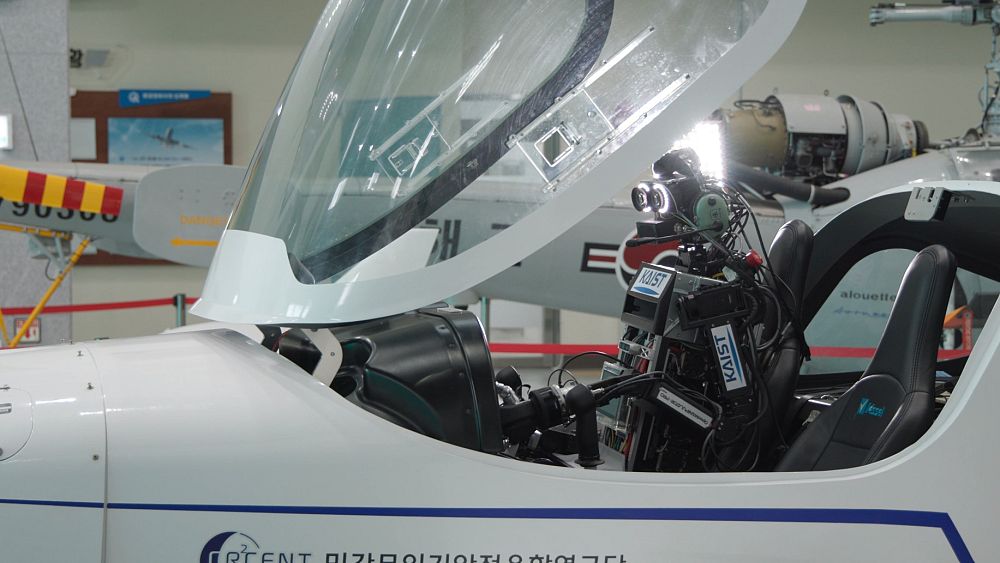As artificial intelligence (AI) and robotics continue to evolve at an astonishing pace, the possibility of technology surpassing human capabilities in various professions looms ever closer. A remarkable leap in this direction is being made by a dedicated team of engineers and researchers at the Korea Advanced Institute of Science & Technology (KAIST), who are developing an innovative humanoid robot capable of piloting aircraft without requiring any modifications to the cockpit.
Named Pibot, this humanoid robot is designed to operate an airplane just like a human pilot would, manipulating all the necessary controls within the cockpit, which is inherently designed for human use. David Shim, an associate professor of electrical engineering at KAIST, shared insights with Euronews Next, stating, “Pibot is a humanoid robot that can fly an aeroplane just like a human pilot by manipulating all the single controls in the cockpit, which is designed for humans.”
Pibot is equipped with advanced capabilities, enabling it to control its arms and fingers with remarkable dexterity to interact with flight instruments, even amidst significant vibrations that occur during flight. High-precision control technology is at the heart of its functionality, ensuring safe and accurate operation.
Utilizing external cameras, Pibot can effectively monitor the aircraft’s current state, while internal cameras assist in managing critical switches on the control panel. One of Pibot’s most impressive features is its ability to memorize complex manuals presented in natural language, greatly enhancing its adaptability across various types of aircraft.
With an extensive memory capacity, Pibot can retain all Jeppesen aeronautical navigation charts from around the globe, a feat that far exceeds human capabilities, according to the KAIST team. Shim elaborated, “Humans can fly many aeroplanes, but they have habits built into them. When transitioning between different aircraft, they often require additional qualifications. These habits can complicate the learning process.” He further explained, “With the pilot robot, if we teach it the configuration for individual aeroplanes, then it can fly by simply selecting the type of aircraft.”
Advancements Enabled by Large Language Models
The research team highlights that Pibot’s ability to “understand” and memorize manuals originally intended for human pilots has been significantly enhanced by recent advancements in large language models (LLM). Shim reflected on the evolution of their project, stating, “Our predecessor to the pilot robot was developed in 2016. At that time, we lacked robust AI technology, so our creation was quite basic and couldn’t learn from literature or manuals. However, with the advent of systems like ChatGPT and other large language models, we have witnessed groundbreaking progress.”
Thanks to these advanced LLMs, Pibot is anticipated to operate flights with greater accuracy than human pilots, responding to emergencies with remarkable speed. It can memorize aircraft operation manuals and emergency protocols (such as the Quick Reference Handbook, or QRH) and execute responses instantaneously. Furthermore, Pibot can calculate optimal flight routes in real-time based on the aircraft’s current status.
While the research team utilizes ChatGPT, they are also in the process of developing a bespoke natural language model that will allow Pibot to make inquiries without relying on an Internet connection. This specialized language model will focus exclusively on piloting information and will be stored on a compact computer designed for onboard use.
Versatile Capabilities Beyond Aviation
Pibot’s design enables it to be directly integrated into aircraft systems, facilitating seamless communication. It is primarily intended for deployment in extreme situations where human intervention may not be optimal. Pibot can communicate with air traffic controllers and other individuals in the cockpit using advanced voice synthesis, allowing it to function effectively as either a pilot or co-pilot.
Moreover, Pibot’s humanoid structure makes it suitable for various roles beyond aviation. Standing at 160 cm and weighing 65 kg, its design allows it to potentially replace humans in tasks such as driving vehicles, operating military tanks, or commanding naval vessels. Shim emphasized that this robot can be employed in any scenario where a human is currently “sitting and working.”
He elaborated, “Although the human form may not be the most efficient, we deliberately designed Pibot to resemble humans because existing systems are built for human interaction. While we could have created a robot with eight arms and four eyes, we found that the human form is, in many ways, optimal for our purposes.”
Currently, Pibot is still under development, with plans for completion by 2026. This innovative research project has been commissioned by the Agency for Defense Development (ADD), the South Korean government body responsible for advancing defense technology. Looking to the future, Shim envisions potential military applications for Pibot.
To learn more about this groundbreaking technology, be sure to watch the video in the media player above.

Leave a Reply